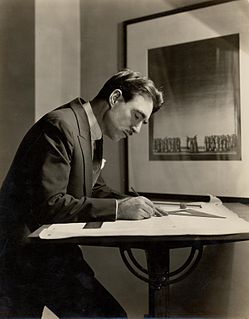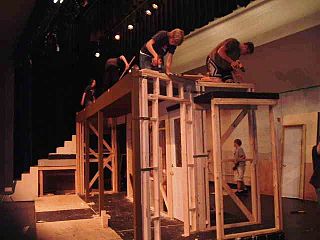
Stagecraft is the technical aspect of theatrical, film, and video production. It includes constructing and rigging scenery; hanging and focusing of lighting; design and procurement of costumes; make-up; stage management; audio engineering; and procurement of props. Stagecraft is distinct from the wider umbrella term of scenography. Considered a technical rather than an artistic field, it is primarily the practical implementation of a scenic designer's artistic vision.

Theatrical scenery is that which is used as a setting for a theatrical production. Scenery may be just about anything, from a single chair to an elaborately re-created street, no matter how large or how small, whether the item was custom-made or is the genuine item, appropriated for theatrical use.

Set construction is the process undertaken by a construction manager to build full-scale scenery, as specified by a production designer or art director working in collaboration with the director of a production to create a set for a theatrical, film, or television production. The set designer produces a scale model, scale drawings, paint elevations, and research about props, textures, and so on. Scale drawings typically include a groundplan, elevation, and section of the complete set, as well as more detailed drawings of individual scenic elements which, in theatrical productions, may be static, flown, or built onto scenery wagons. Models and paint elevations are frequently hand-produced, though in recent years, many Production Designers and most commercial theatres have begun producing scale drawings with the aid of computer drafting programs such as AutoCAD or Vectorworks.

Scenic design is the creation of theatrical, as well as film or television scenery. Scenic designers come from a variety of artistic backgrounds, but in recent years, are mostly trained professionals, holding a B.F.A. or M.F.A. degrees in theater arts. Scenic designers design sets and scenery that aim to support the overall artistic goals of the production. There has been a consideration that scenic design is also production design; however, more accurately, it is a part of the visual production of a film or television.
Set, The Set, or SET may refer to:

A prop, formally known as (theatrical) property, is an object used on stage or screen by actors during a performance or screen production. In practical terms, a prop is considered to be anything movable or portable on a stage or a set, distinct from the actors, scenery, costumes, and electrical equipment. Consumable food items appearing in the production are also considered props.
A scenographer or production designer, develops the appearance of a stage design, a TV or movie set, a gaming environment, a trade fair exhibition design or a museum experience exhibition design. The term originated in theater. A scenographer works together with the theater director to make the message come through in the best way they think possible, the director having the leading role and responsibility particularly for dramatic aspects - such as casting, acting, and direction - and the scenographer primarily responsible for the visual aspects or "look" of the production - which often includes scenery or sets, lighting, and costumes, and may include projections or other aspects.

In theatre and performing arts, the stage is a designated space for the performance of productions. The stage serves as a space for actors or performers and a focal point for the audience. As an architectural feature, the stage may consist of a platform or series of platforms. In some cases, these may be temporary or adjustable but in theaters and other buildings devoted to such productions, the stage is often a permanent feature.

A stagehand is a person who works backstage or behind the scenes in theatres, film, television, or location performance. Their work include setting up the scenery, lights, sound, props, rigging, and special effects for a production.
In drama, a scene is a unit of action, often a subdivision of an act.

Theater drapes and stage curtains are large pieces of cloth that are designed to mask backstage areas of a theater from spectators. They are designed for a variety of specific purposes, moving in different ways and constructed from various fabrics. Many are made from black or other darkly colored, light-absorbing material. Theater drapes represent a portion of any production's soft goods, a category comprising any non-wardrobe, cloth-based element of the stage or scenery. Theater curtains are often pocketed at the bottom to hold weighty chain or to accept pipes to remove their fullness and stretch them tight.
A theatrical technician, is a person who operates technical equipment and systems in the performing arts and entertainment industry. In contrast to performers, this broad category contains all "unseen" theatrical personnel who practice stagecraft and are responsible for the logistic and production-related aspects of a performance including designers, operators, and supervisors. Many professional designers and technicians consider the diminutive "techie" to be offensive.

In theaters, a batten is a long metal pipe suspended above the stage or audience from which lighting fixtures, theatrical scenery, and theater drapes and stage curtains may be hung. Battens that are located above a stage can usually be lowered to the stage or raised into a fly tower above the stage by a fly system.
The prompt book, also called transcript, the bible or sometimes simply "the book," is the copy of a production script that contains the information necessary to create a theatrical production from the ground up. It is a compilation of all blocking, business, light, speech and sound cues, lists of properties, drawings of the set, contact information for the cast and crew, and any other relevant information that might be necessary to help the production run smoothly and nicely.

Ultra Wave is the fifth album released by funk musician Bootsy Collins. It was released on November 12, 1980 by Warner Bros. Records. It is the first album credited solely to Bootsy Collins, as opposed to his previous releases, which were credited to Bootsy's Rubber Band. In 2007, "Ultra Wave" was licensed through Rhino Records and reissued through the Collectors Choice music service.

A scenery wagon, also known as a stage wagon, is a mobile platform that is used to support and transport movable, three-dimensional theatrical scenery on a theater stage. In most cases, the scenery is constructed on top of the wagon such that the wagon, and the scenery it supports, forms a single, integrated structure. Heavy duty casters are mounted to the underside of the platform so that the entire assembly can be quickly moved onstage or offstage, so as to facilitate rapid scenery changes during live productions. Scenery wagons are built in a wide range of sizes, ranging from less than one square foot up to the size of the playing area of the stage.
The following outline is provided as an overview of and topical guide to stagecraft:
Rigging in entertainment can be broken down into two main subjects – theatrical rigging and arena style rigging. All the same skills apply in both genres. The first takes place in a theatre, and typically involves the theatre's permanent fly system. The other in an arena or "exposed structure venue" such as a convention center, ballroom, warehouse etc. Many arena riggers find themselves hanging a full proscenium theater in an arena environment.
Peter L. Feller was an American theatrical set builder who worked primarily on Broadway. He was born in New York City on November 7, 1919. His wife was Katherine "Kay" Feller. Together, they had two sons, Peter and Philip, and three granddaughters. Feller also had two sisters. He died in 1998, at the age of 78, in Melbourne, Florida, where he was living. His memorial service was held at the Winter Garden Theater, where Cats was performing.










